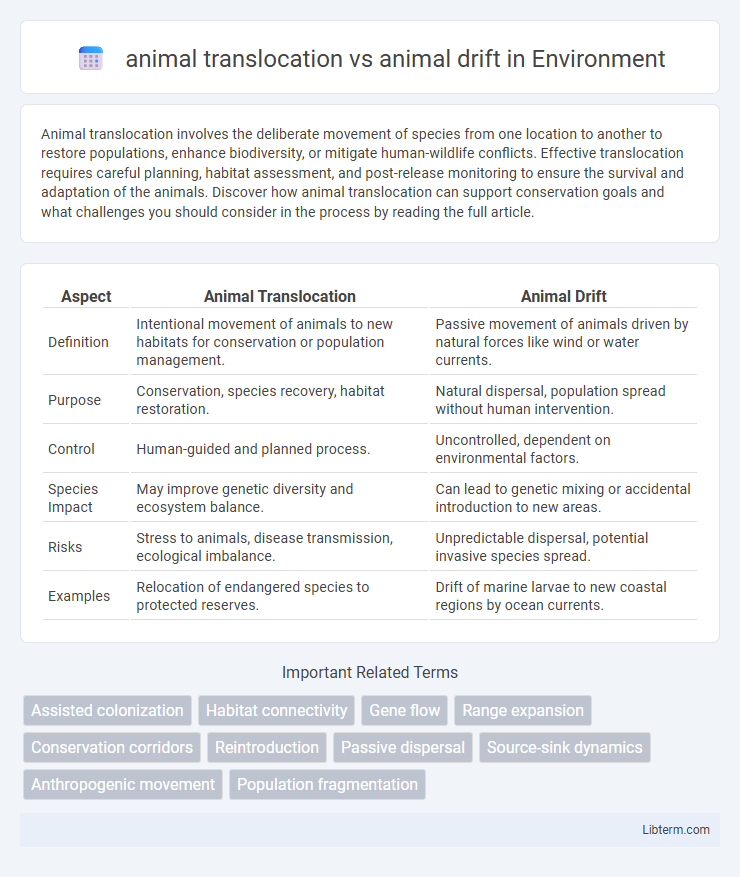Animal translocation involves the deliberate movement of species from one location to another to restore populations, enhance biodiversity, or mitigate human-wildlife conflicts. Effective translocation requires careful planning, habitat assessment, and post-release monitoring to ensure the survival and adaptation of the animals. Discover how animal translocation can support conservation goals and what challenges you should consider in the process by reading the full article.
Table of Comparison
| Aspect | Animal Translocation | Animal Drift |
|---|---|---|
| Definition | Intentional movement of animals to new habitats for conservation or population management. | Passive movement of animals driven by natural forces like wind or water currents. |
| Purpose | Conservation, species recovery, habitat restoration. | Natural dispersal, population spread without human intervention. |
| Control | Human-guided and planned process. | Uncontrolled, dependent on environmental factors. |
| Species Impact | May improve genetic diversity and ecosystem balance. | Can lead to genetic mixing or accidental introduction to new areas. |
| Risks | Stress to animals, disease transmission, ecological imbalance. | Unpredictable dispersal, potential invasive species spread. |
| Examples | Relocation of endangered species to protected reserves. | Drift of marine larvae to new coastal regions by ocean currents. |
Understanding Animal Translocation: Definition and Purpose
Animal translocation involves the deliberate capture, transport, and release of wildlife to new locations aimed at species conservation, habitat restoration, or population management. This process contrasts with animal drift, which refers to the passive movement of animals through currents or environmental forces without human intervention. Understanding animal translocation is crucial for biodiversity preservation as it helps mitigate habitat loss and genetic bottlenecks in threatened species.
What is Animal Drift? Key Concepts Explained
Animal drift refers to the passive movement of organisms, especially aquatic species, carried by water currents, tides, or wind, often resulting in displacement from their original habitat without deliberate locomotion. Unlike animal translocation, which is an intentional human-mediated relocation of animals to new environments for conservation or management purposes, animal drift occurs naturally and can influence population dispersal and gene flow. Understanding drift dynamics is crucial for ecological studies and managing species distribution, especially in riverine and marine ecosystems.
Differences Between Translocation and Drift in Wildlife Management
Animal translocation involves the intentional capture and movement of wildlife by humans to new locations for conservation or population control purposes. In contrast, animal drift refers to the passive, unintentional movement of animals due to environmental factors such as water currents, wind, or habitat changes. Translocation is a management strategy with controlled outcomes, while drift is a natural, unpredictable process affecting animal distribution.
Ecological Impacts: Translocation vs Animal Drift
Animal translocation involves intentional relocation of species to restore populations or manage ecosystems, directly influencing genetic diversity and habitat connectivity, while animal drift refers to passive movement due to environmental factors like currents, often resulting in unplanned distribution shifts that can disrupt local ecosystems. Translocation can enhance ecosystem resilience by introducing keystone species or genetic variants, but risks include unintended spreading of diseases or invasive behaviors. In contrast, animal drift may cause unpredictable ecological consequences, such as altered community structures or mismatched predator-prey dynamics, affecting biodiversity and ecosystem stability.
Genetic Consequences of Animal Movement Strategies
Animal translocation, involving deliberate relocation of individuals by humans, often leads to increased genetic diversity by introducing new alleles into isolated populations, enhancing gene flow and reducing inbreeding depression. In contrast, animal drift, characterized by natural, passive movements such as ocean currents or winds, can result in random genetic mixings that may either increase genetic variation or cause genetic homogenization depending on environmental factors. Both movement strategies significantly impact population genetic structure, influencing adaptive potential and long-term species survival.
Environmental Factors Influencing Translocation and Drift
Environmental factors significantly influence animal translocation and drift, with habitat quality, climate conditions, and geographic barriers playing key roles in success rates. Translocation outcomes often depend on the suitability of release sites, including availability of food, shelter, and absence of predators, while drift is primarily affected by water currents, wind patterns, and landscape connectivity. Understanding these factors enables more effective management strategies, ensuring population stability and biodiversity conservation in changing ecosystems.
Human Roles: Interventions vs Natural Dispersal
Animal translocation involves deliberate human intervention to move species across landscapes for conservation or management purposes, ensuring population connectivity or reintroduction. In contrast, animal drift relies on natural dispersal mechanisms such as wind, water currents, or animal behavior without direct human involvement. Understanding the distinction between these processes highlights the impact of human actions on biodiversity and ecosystem dynamics.
Case Studies: Successful Animal Translocation Projects
Case studies of animal translocation projects demonstrate significant successes in restoring endangered species, such as the swift fox reintroduction in the Great Plains and the Arabian oryx revival in Oman. These projects highlight strategic planning, habitat suitability, and post-release monitoring as critical factors for translocation success, contrasting with animal drift, which involves passive movement without human intervention. Effective translocation enhances biodiversity conservation by actively reestablishing viable populations in target habitats, reducing extinction risks linked to habitat fragmentation and human activities.
Conservation Challenges: Risks of Drift and Forced Movement
Animal translocation involves the intentional relocation of species to support conservation, but it carries risks like genetic bottlenecks and disruption of social structures. Animal drift, referring to unintentional movement caused by environmental factors such as currents or habitat fragmentation, can lead to population isolation and decreased genetic diversity. Both forced movement and drift contribute to challenges like increased mortality rates and altered ecosystem dynamics, complicating species recovery efforts.
Future Directions: Integrating Translocation and Drift in Conservation Planning
Integrating animal translocation and drift in conservation planning requires advanced spatial modeling and genetic analysis to predict movement patterns and enhance population connectivity. Emerging technologies such as GPS tracking and environmental DNA (eDNA) can monitor both intentional translocations and natural dispersal, informing adaptive management strategies. Future conservation frameworks must combine these approaches to maintain genetic diversity and ecosystem resilience in changing landscapes.
animal translocation Infographic

 libterm.com
libterm.com